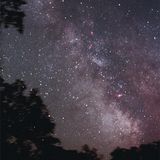
Dew forms on any surface that is sufficiently colder than the air temperature. The dew point varies with both temperature and humidity. Odd as it may seem, the temperature of an object exposed to the night sky rapidly becomes colder than the ambient air. This radiant cooling takes place when an object gives off more heat than it absorbs from the surrounding environment. If the temperature drops enough to reach the dew point, dew forms.
Dew is particularly troublesome on Schmidt-Cassegrain telescopes, with their exposed front corrector plate. Once dew forms, wiping it away does no good; it just keeps forming. To prevent dew, you must either slow down the radiant cooling (with a dew cap) or replace lost heat (with a heater), or both.
Dew Caps
A dew cap is a hollow tube that extends out in front of the objective lens (refractors) or corrector lens (Schmidt-Cassegrains). It shields the exposed optics from wide exposure to the cool ambient air, slowing heat loss. Reflector telescopes don’t need dew caps because the main mirror rests at the bottom of the tube, which acts as a dew shield. A dew cap works best if made from an insulating material. It will prolong viewing time and can prevent dew formation entirely.
Dew Heaters
A dew heater warms the telescope’s corrector plate to a temperature higher than the dew point. There are several different types:
Warm air blowers, such as home hair dryers, can rapidly warm up optics and evaporate dew. They work well for casual observing, but must be used repeatedly and can cause temporary image distortion.
Heated dew caps warm the air around the corrector, heating it by convection. This eliminates dew, but can cause "heat wave" optical effects, which distort the image.
Contact heaters are electric heating elements that directly warm the telescope tube or optical mounting cell, which conducts heat directly to the optics. They avoid heating the air or the dew cap, thereby minimizing heat waves and other undesirable thermal effects.















